17 Dec 2004
I arrived in Zanzibar by boat. I am
staying at Safari Lodge Hotel, a very clean and affordable little
hotel. It is in Kiponda, the older part of Stone Town full of narrow
alleys. The lanes are bit filthy, congested and with a stench in
places (rotting rubbish in alley corners).
Since
they are full up tomorrow, I move to an equally clean and affordable
hotel near the Court House. This suburb, Shangani, has better
maintained paving, cleaner streets and is where the British
colonials lived and worked.
I got a
seat on a flight from Zanzibar to Mombasa on 3 Jan. There is only
one more seat left. It costs US $ 110 one way, about GBP 60 Brutish
Pound - compare that to GBP £320 for a return charter flight from
London to Mombasa, one fifth the price for a hundredth of the
distance. The planes monopoly is earning big profits for the South
African operators!!
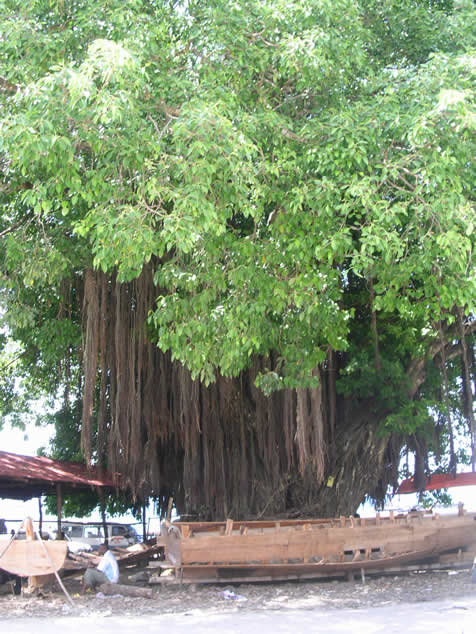
The famous big baobab tree under which boats are
repaired and dhow journeys are negotiated.
This is a few yards
from the dispensary, near the ferry port and opposite Mercury's
Restaurant
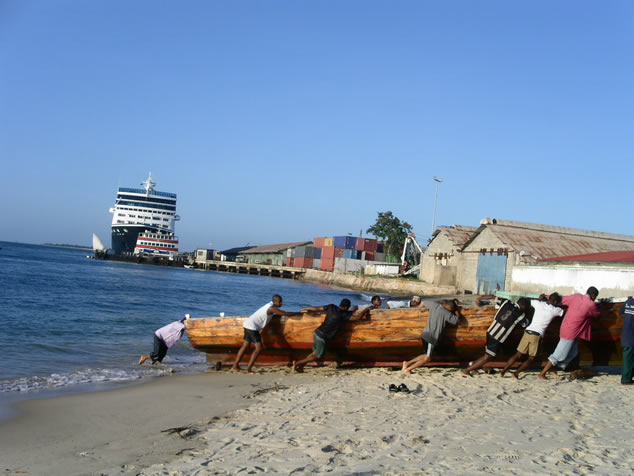
A variety of
ships: Pushing a boat for repairs. A freight ship at the port.
A
dhow with triangular sail. A passenger ferry ready to depart for Dar
es Salaam
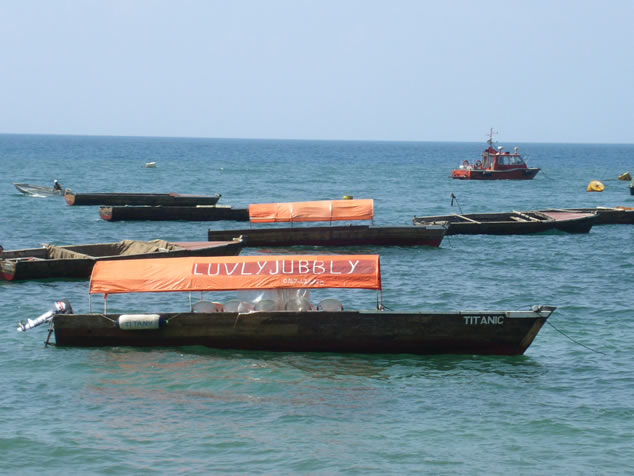
The view
opposite the tree. Dell Boy's expression is even on a Zanzibari boat
going to the islands opposite.
(Dell Boy is a character in
British TV comedy "Fools and Horses")
I was
talking to a freight company's owner. He was saying the export
import trade is booming so much in the Indian Ocean that he has more
cargo than ships to deliver it by. How different from Europe where
they do such intensive marketing to get customers. Who says Africa
is poor!
I had a walk about in the market. Wonderful fresh fruits and
vegetables and fish etc. Diju-bhai Joshi showed me around the market
and explained me some of the exotic fruits. There were a few "inzee"
but it was not too bad.
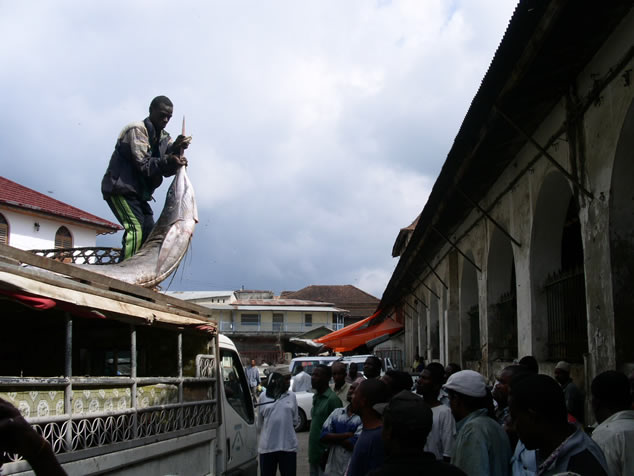
Large fish
being unloaded - a marlin
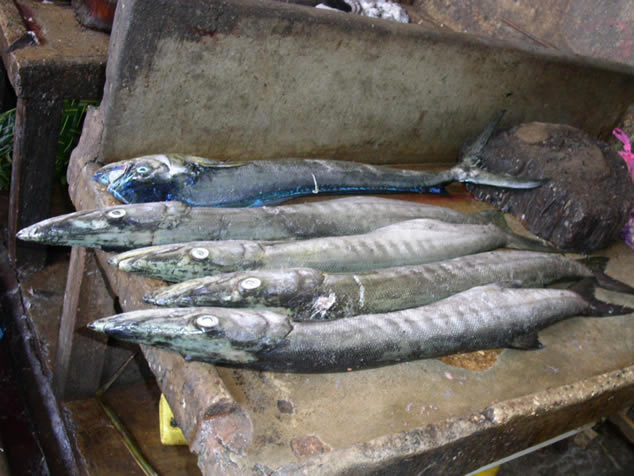
Barracuda
and which fish?
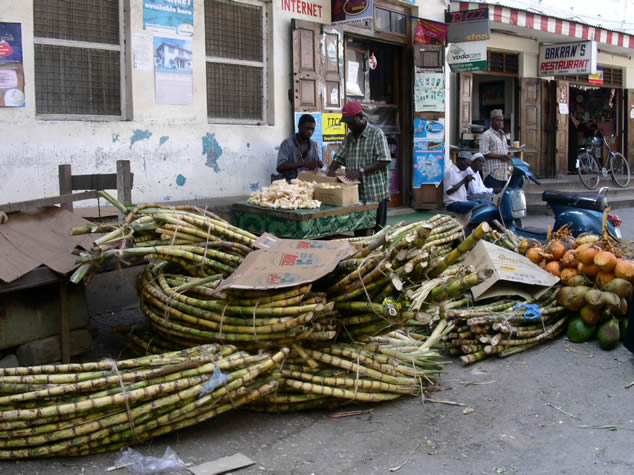
Diju-bhai
Joshi runs a seafront Indian food restaurant and recruits passing
tourists into trips for a commission. His brother Dipak spends a
good proportion of his time in Canada. Diju-bhai used to be a school
teacher and so is well-known in the town. He is very charming to
tourists, gives them all sorts of helpful information and sometimes
reads their palms to tell them their future. Diju-bhai was delighted
with my Gujarati and said it was good to have proper Gujarati
conversation for a change since most Indians speak a lot of
Kiswahili and English or mix their languages in each sentence.
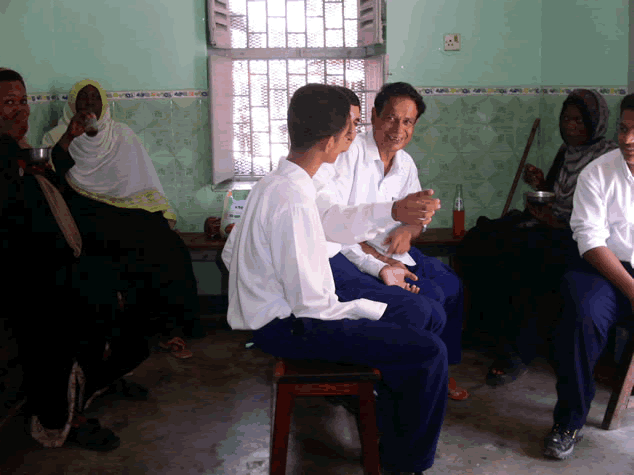
Diju-bhai took me to a tiny shop in the market where
a kiswahili lady sells "mix" (indian savoury with tamarind sauce),
samosas, snacks, tea and soda. Some school boys were there to eat
during their school break. They recognised Diju-bhai and had a chat
with him. Young people are still so respectful of their elders in
Zanzibar.
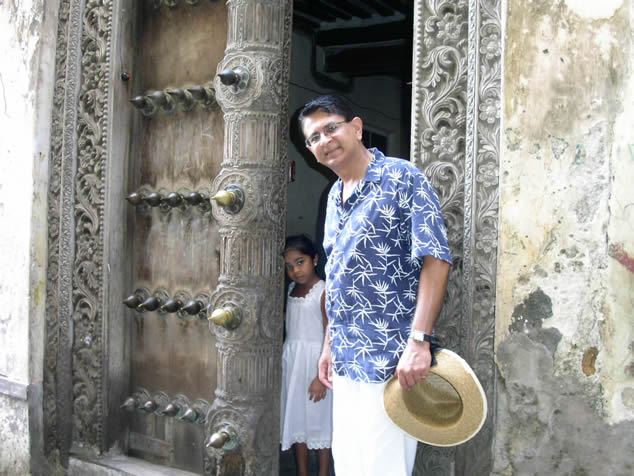
Diju-bhai
showed me this door and explained that it was of Arabic style, which
is the carving in the frame and no squares on the door itself. The
large metal studs are inserted in door frames for a good reason; in
medieval times, invaders guided their elephants to push down the
doors of courtyard houses but elephants shied away from doors with
spiky studs that would hurt them on pushing! The little girls lives
there.
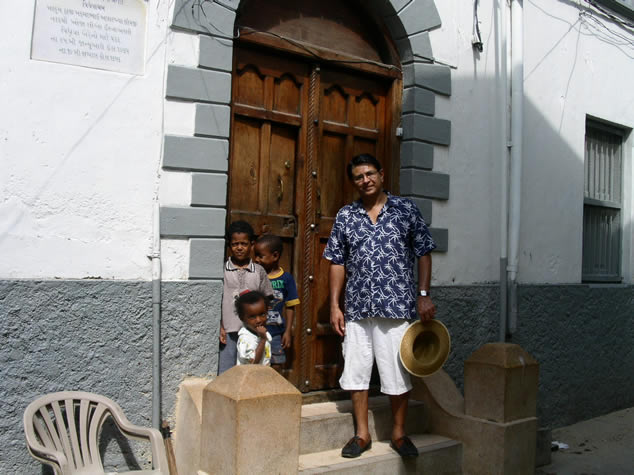
At the
doorstep of the "Khoja Shia Ishna-Asheri Widhwa-ashram" (house for
widows). The door is in Indian style which has plain squares
layout. Notice a small door (behind the children) within the main
door for daily use.
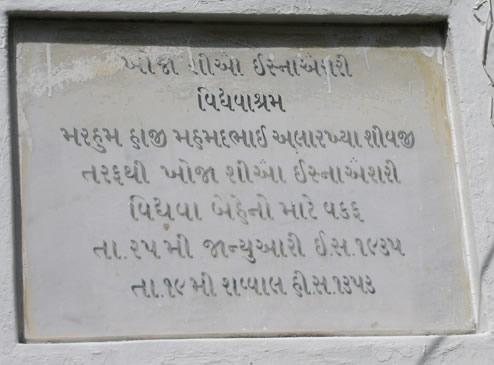
Translation
of the stone tablet to the left of the door:
Khoja Shia
Ishna-Asheri
Widhwa-ashram
Marhoom (deceased) Haji
Mohamed-bhai Alarakhya Sheewji
settlement to khoja shia ishna
asheri
widowed ladies (wakaf = charitable gift)
dated 25th
January 1935 (Christian calendar)
dated 19th Shawal Hijri 1353
(Islamic calendar)
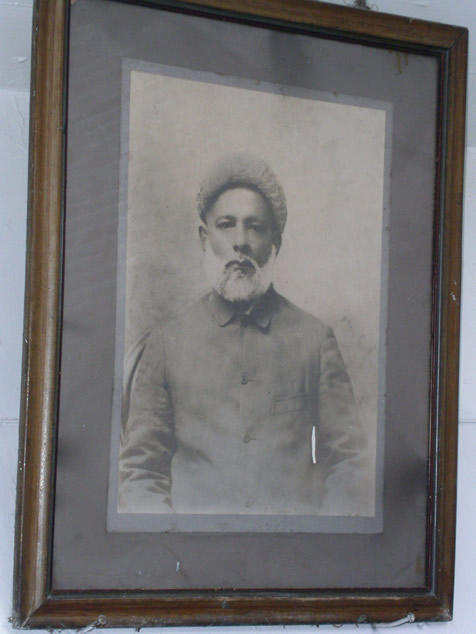
This
photograph of Marhoom (deceased) Haji Mohamed-bhai Alarakhya
Sheewji,
about 2 feet by two feet, hangs opposite the entrance
door inside the courtyard of the building.
This building is
part of the heritage of the Khoja Shia Ishna-Asheri but sadly it is
under-utilised.
It located three minutes walk behind the jooni
(older) masjid in Kiponda suburb or Stone Town, Unguja Island of
Zanzibar. It is laid out in the traditional easter quadrangle. As
you enter, there are a couple individual rooms each with a door from
the central open space. The photo is on the far side of the wall. On
the right is a wooden staircase going to the upper floor. The lower
floor is occupied by the caretaker and a few Swahili widows, who are
very polite and modest ladies. Upstairs is guesthouse for KSI
travellers. There are three rooms, each with four beds and hardly
any other furniture. There are overhead fans and windows but no
air-conditioning. To the far left corner are two latrines and one
sit-down on a wooden stool bathroom. The place is tidy but so basic
that hardly any KSI guests stay there. It is a well-maintained and
sturdy building. With some renovation and a little interior
decoration and furnishing, it can be a wonderful and cheap place for
KSI visitors from around the world to stay in a building left for
them by one of their forefathers. The guest house nearby in Kiponda
is derelict and closed since it was occupied by apparently Pemba
squatters who ran down the building. The property is understood to
be still in KSI ownership there and so a new hostel could be built
there one day.
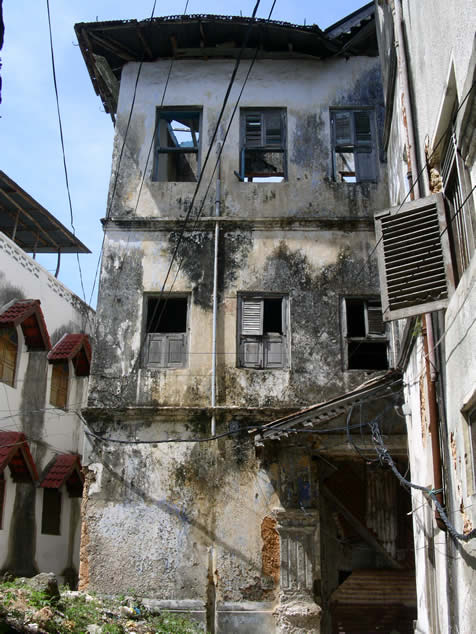
KSI
Guest House from the front
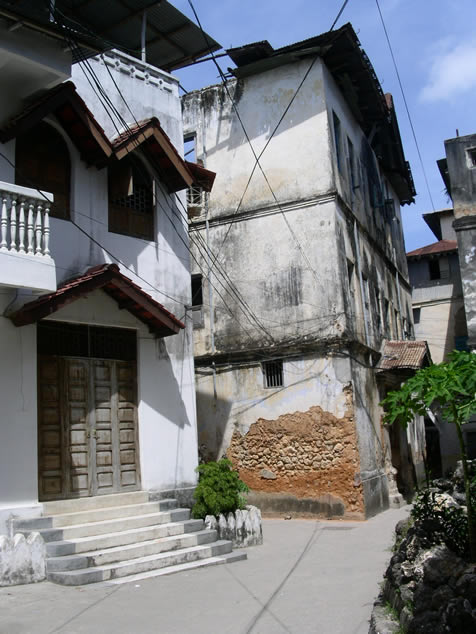
KSI Guest
House from the side (the derelict one to the
right)
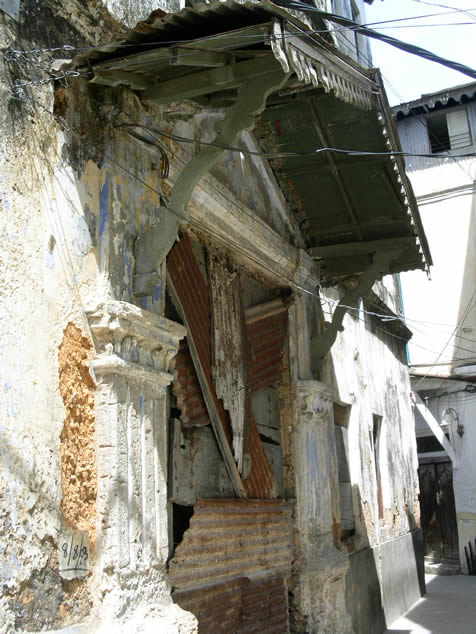
KSI Guest
House entrance door boarded up
Here is a remarkable building in Kiponda, near Safari Inn
(owned by Zuli of the speed boat from Dar es Salaam to Zanzibar). It
is a historic building but it is overcrowded and badly utilised by
so many people staying in there. It is a large building with room
around a central courtyard.
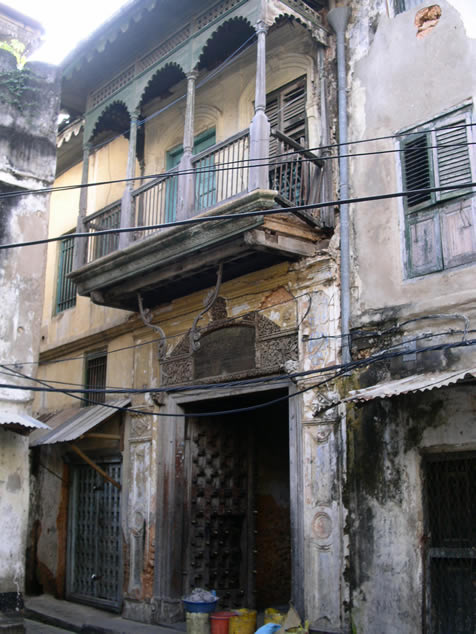
CHARITABLE CARAVANSERA
Established and
endowed by Khoja Esmal Ramjee of Cutch Sama-Goga for the
use of
only the khoja caste travellers in the reign of H H the Sultan Sayid
Ally Bin
Sayeed of Zanzibar. December 29th 1892
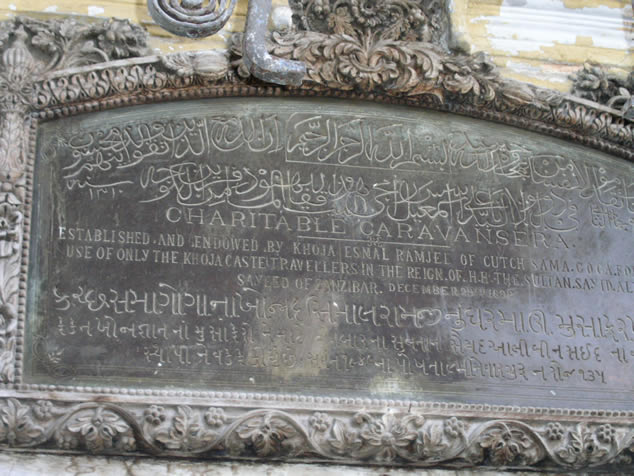
The sign above the entrance mentions Khoja but it is not
clear whether it is all khoja or khoja Ismailis only. That is about
the time that the Ismaili community split and some left to turn into
Shia Ishn-Asheri. The first leader of KSI was not allowed to be
buried at the Ismaili cemetery and so his grave is at the KSI jooni
masjid (KSI older mosque) in Kiponda. I was shown the grave from the
first floor window.
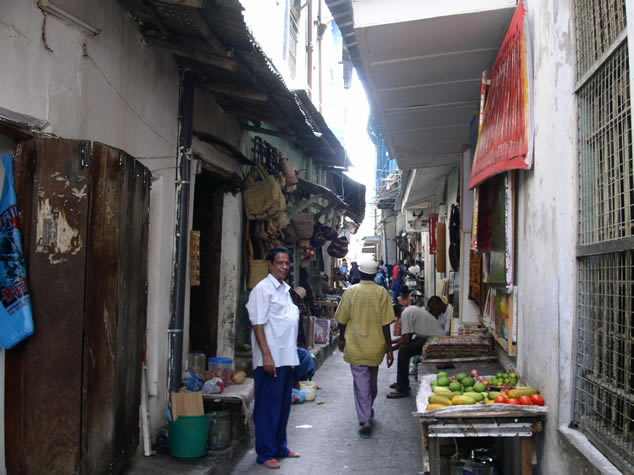
Here is an
alley popular with tourists. It goes from near the Post Office in
Shangani to go to the Catholic Church, Emerson & Green hotel
(roof top restaurant is always full up with tourists) and all the
way to the Anglican Church built on the site of the slave market.
Amazing variety of things are sold from the doorways of little shops
but prices for tourists are much higher, must haggle unless you can
sort them out in kiswahili. They got very confused with me because I
looked a tourist but I talked in their own lingo. :-)
I
branched off as Diju-bhai had work to catch up with his work and he
is vegetarian, a strict Hindu. I went for lunch to Mercury's
waterfront restaurant, and had kuku wa kwapaka, that
quintessentially Kiswahili dish.
I spent the afternoon at "Bayat ul Ajayb". It is a big hall
with galleries on three floors.
Lovely ornaments and artifacts.
Hardly any security; antiques thieves could easily take old things
on display.
Here are the views of the four sides from the top
floor.
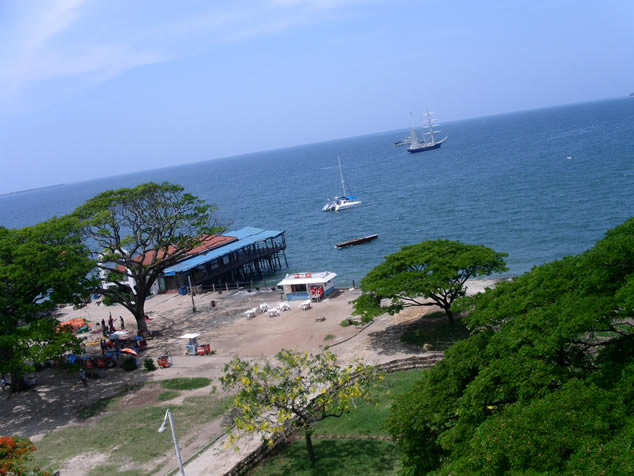
Looking out
to Foradhani. The sea front is looking west, that is where you see
sunset.
It is 37 degrees Centigrade and humid. Bring me more
madaf. My madaf man with a cart was just by the water front. I would
have two or three at a time and left him the change.
At night
time it has lines of stalls selling cheap eats from mishkaki to fish
kebabs, sugar cane juice, tea and mandazi, zanzibar pizza (thin
pastry filled with minced beef meat, chopped onions, a whole egg,
all folded in a square and then fried on both sides). The eats are
very cheap but not all of it is fresh or hygienic and so you take
your chances. I had a few skewers of mishkaki with no ill effects. I
would eat zanzibari pizza and then go to Rashidi's stall to have
spicy tea and mandazi and afterwards tangawizi (ginger) tea, sit on
the bench at the table and chat with all sorts (locals and tourists
alike) who would sit there for a few minutes drinking their tea. I
made many local friends including Ali Baba.
One day I was so
tempted by sugar cane juice, I bought a small plastic bottle of
mineral water and then asked the man "tiya hiyo moja kwa moja kwa
bottle yangu, bila ice" and he did get it straight into the bottle -
no ill effects, and it was delicious, just 25 pence or half US
dollar! At night time there is no public lighting but the charcoal
grates and tadoba (oil lams) and storm lights make an amazing
setting.
That restaurant with blue roof is abandoned, they say a
white South African operator ran it for a couple of years and then
disappeared without paying his tax liability! The whole of Foradhani
is being redeveloped by Aga Khan, from his hotel Serena to the dock
and so Mercury's restaurant will be gone.
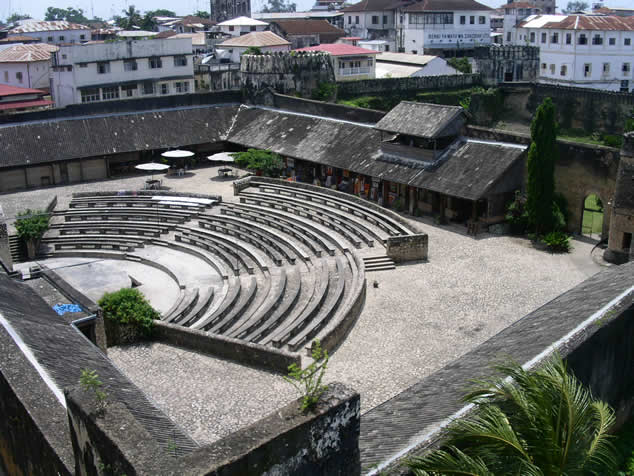
Looking on
the left immediately below. The inside of the fort has an
amphitheatre. Almost every Saturday night there is live music or
gomma dance or some cultural event. I never got an opportunity or
inspiration to go there. The ticket would include food and drink.
During the day, the shops sell curios. Little tourist children
wearing local dress and looking at paintings for sale - how cute!
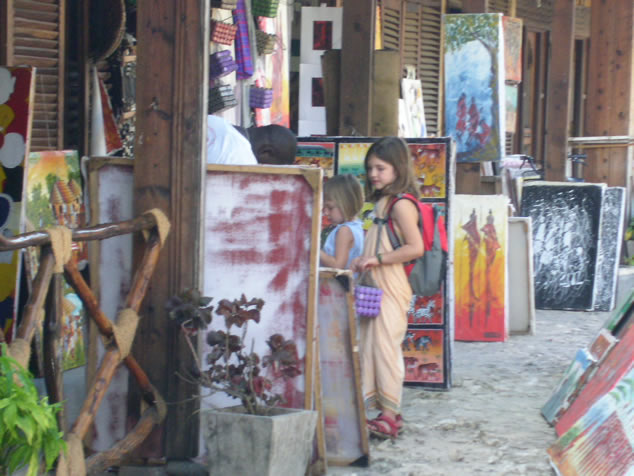
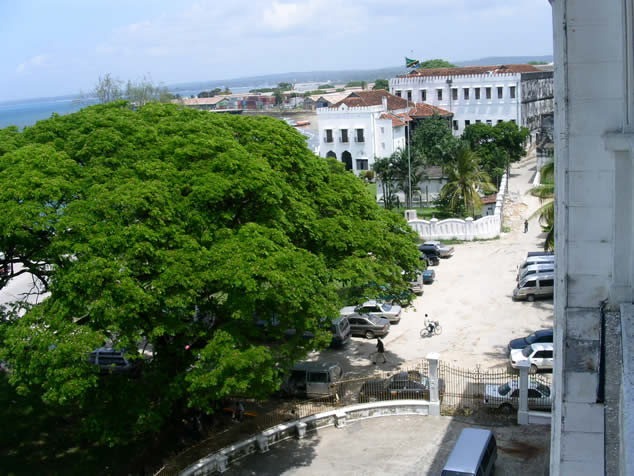
Looking to
the right towards the docks.
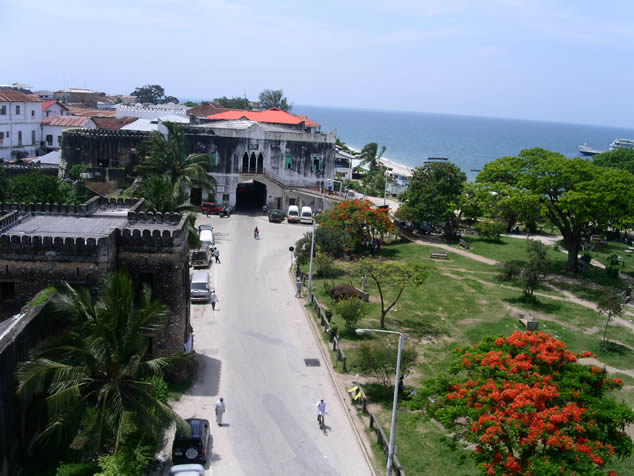
Looking left
towards Shangani. Cars go through the tunnel under the building.
Above the tunnel there used to be a school. What a lovely tree with
red flowers. The trees are neglected; has some dead branches. The
grass is neglected too. Taxi drivers parked along there will always
ask "Taxi???" and it is best to smile and say "Badai" (later on
perhaps).
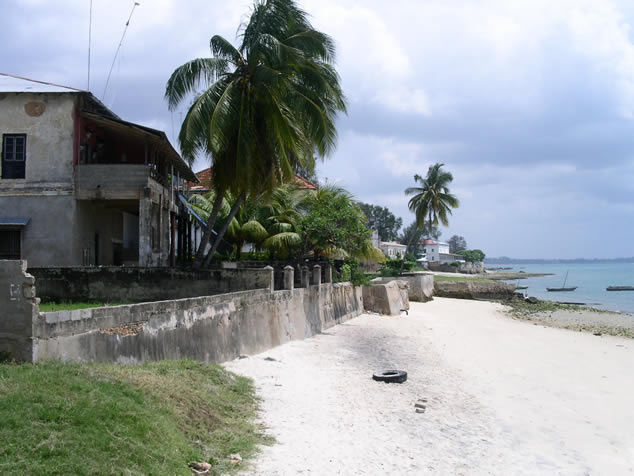
Through the
arch into Shangani, towards the beach, looking towards Sarena Hotel.
It is low tide now. At high tide just before sunset a lot of young
men do acrobatics and then jump into the water. Very lively and
noisy; better than watching television and playing nasty games on
"Game Boy"
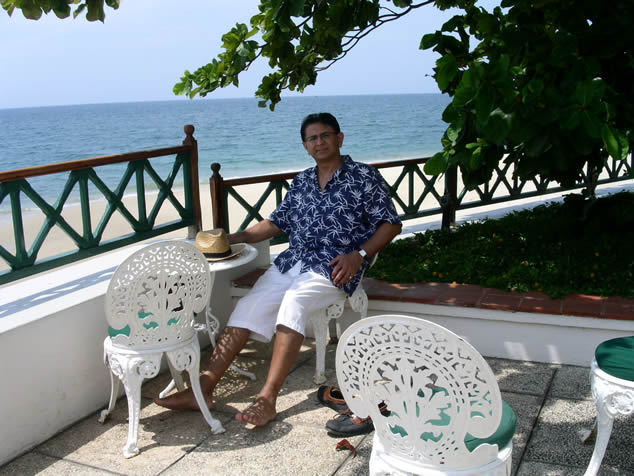
Having a cool
off at Sarena Hotel by the swimming pool at the water's
edge.
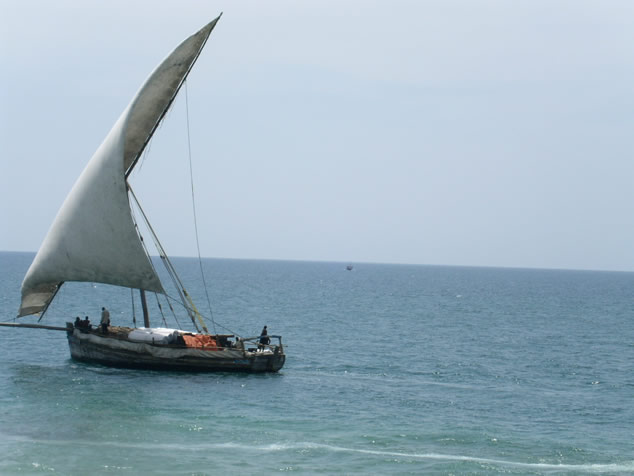
A dhow
shuffles past Sarena Hotel. Once I saw two dolphins
here!
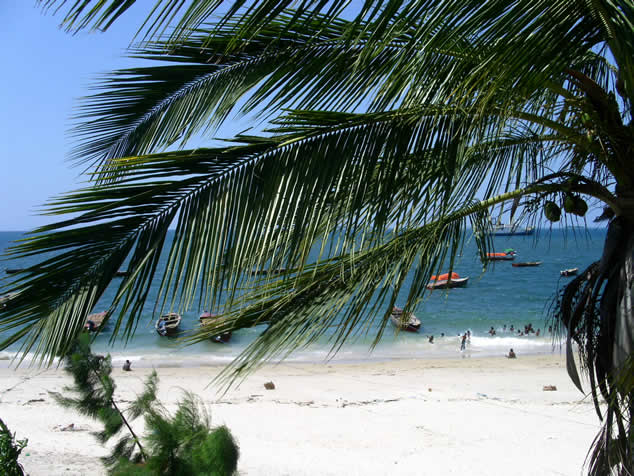
School
children on holiday having a swim and fun time
| ![]()
![]()